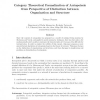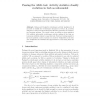ECAL
2001
Springer
14 years 5 months ago
2001
Springer
ECAL
2001
Springer
14 years 5 months ago
2001
Springer
Since the concept of autopoiesis was proposed as a model of minimal living systems by Maturana and Varela, and applied to social systems by Luhmann, there has been only a few math...
ECAL
2001
Springer
14 years 5 months ago
2001
Springer
Reinforcement learning (RL) is a fundamental process by which organisms learn to achieve a goal from interactions with the environment. Using Artificial Life techniques we derive ...
ECAL
2001
Springer
14 years 5 months ago
2001
Springer
ECAL
2001
Springer
14 years 5 months ago
2001
Springer
Flying insects use highly efficient visual strategies to control their self-motion in three-dimensional space. We present a biologically inspired, minimalistic model for visual �...
ECAL
2001
Springer
14 years 5 months ago
2001
Springer
In this paper a formal approach to construction of a similarity measure for complex creatures is presented. The simulation model is described, and a Framsticks agent is expressed i...
ECAL
2001
Springer
14 years 5 months ago
2001
Springer
ECAL
2001
Springer
14 years 5 months ago
2001
Springer
This paper presents recent work in computational modelling of diffusing gaseous neuromodulators in biological nervous systems. It goes on to describe work in adaptive autonomous sy...
ECAL
2001
Springer
14 years 5 months ago
2001
Springer
Bedau and Packard’s evolutionary activity statistics [1, 2] are used to classify the evolutionary dynamics in Geb [3, 4], a system designed to verify and extend theories behind t...
ECAL
2001
Springer
14 years 5 months ago
2001
Springer
A crucial feature of evolving natural systems is parallelism. The simultaneous and distributed application of rules (governed by e.g. biochemistry) is generally considered as the p...




